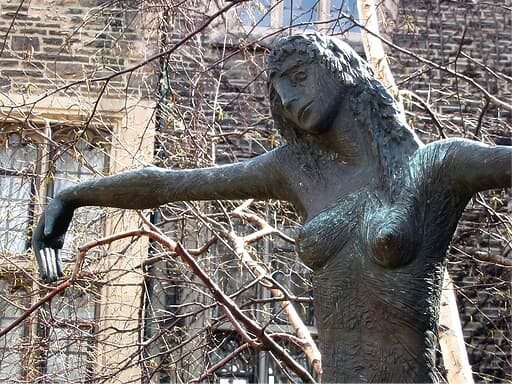Crucified Woman Statue Still Resonates Strongly
Phil Little, Ladysmith, BC
Volume 38 Issue 4, 5 & 6 | Posted: July 7, 2023

Back around 1986 we were living in the small apartment attached to Loretto College on St. Mary Street in the University of Toronto campus area. Next door in an older style house lived David and Nancy Newman. David was a United Church minister. We were invited to the installation of a controversial statue of the “Crucified Woman” in the garden of Emmanuel College.
This sculpture by Almuth Lütkenhaus was not originally intended to be a religious icon but rather the expression of “woman’s suffering”. However it was recognized as a powerful statement and somehow was installed in an area of the Bloor Street United Church. Not everyone appreciated the art nor the message and the pastor, Cliff Elliott, was denounced for heresy which resulted in an investigation by the church Presbytery. The complaint was later dismissed. Whatever the cause of some discomfort with the statue, it needed to be relocated.
A group of students calling themselves the “Uppity Women” and some women theologians connected to Emmanuel College (UCC) arranged for the statue to be relocated and the event was marked with a number of academic events followed by an outdoor worship service. This event was a short five-minute walk from where we lived and it was our connection with David and Nancy that got us on the invitation list. With hymns, dance and a liturgy with traditional prayers a powerful moment was shared.
Attending with us were our small children including our oldest daughter Patricia, then only 5 or 6 years of age. Knowing David and Nancy she wandered away from us and went over to hold hands with them, although David was one of the acting celebrants of the liturgy. At the time of communion Patricia showed an interest and was offered the Eucharist bread. We looked at one another and realised that Patricia had just made her “first communion”.
At the time perhaps the powerful statements being made were foreign to me. The suffering of women, in the world but also in the religious world, had not been an issue for me. For some the image of a naked woman in the crucified form spoke of many dimensions of how women are caused to suffer not only by persons committed to a misogynist mindset but by institutions, academic and religious, for whom the oppression of women was essential to their power structures.
My daughter has grown to become a strong woman, perhaps influenced in ways we did not anticipate with this “first communion” experience. The statue is indeed “heretical” but not in the way of the first accusations against the Rev. Elliott. The word comes from the Greek word “hairesis”, simply meaning different opinions. However when those different views began to challenge the official institutional views, the word evolved into “heresy” for which there could be dire consequences.
The statue remains in the garden of Emmanuel College on the University of Toronto campus as a statement about the suffering of women. Perhaps the institutional form of punishment which was the Roman way is most obvious, but it is speaking to the way even religious institutions have punished “uppity” women over the centuries including the horrendous witch burnings in the times of the Inquisition.
Over the years I have been privileged to work with some of these uppity women in education, church and other organizations. I think of my artist in heaven, Sister Zelma, with whom I worked in northern Peru and whose small water colour sketch of the Madonna gifted to us is much treasured. There are Muriel and Rita, who were Canadian nuns called to be the de facto pastors in the village of Otuzco, near Cajamarca. They were way ahead of anything happening in the Catholic Church. My dear mentor Kathleen who had the courage to help me become sensitive to feminist issues and discussions still guides this old colleague. So many uppity women who have blessed my life with their patience and example.
I was so moved to walk through the campus of Emmanuel College and to see the “crucified woman” still reaching out to passersby with her message, however difficult it is for the world in which we live. In Canada we remember the Missing and Murdered Indigenous Women (MMIW), the discrimination and inequality that women still face at all levels, and the reality of violence suffered by women. Those outstretched arms call for solidarity – from God and humankind.
Phil Little, Ladysmith, BC
